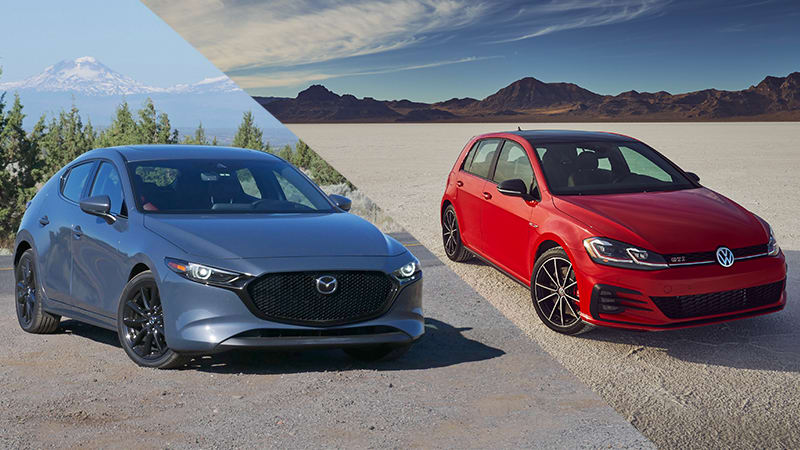For the first time since 2013, Mazda is offering a hopped-up version of its compact hatchback and sedan, the Mazda3. But instead of the rip-snorting “wild child” of yore, this new 2021 Mazda3 Turbo is designed to provide impressive performance while being mature and livable. That sounds rather like the philosophy behind the ur-hot hatch, the 2021 Volkswagen GTI. Not only that, but they have similar performance at similar prices. And having driven both fairly recently, we figured there was no better time to have a look at their specs, talk about our impressions, and show you how they compare.
Performance and Driving Impressions
Both the Mazda and the VW come packing turbocharged four-cylinder engines, but going deeper reveals quite a few differences. The Mazda, with an extra 500 cc of displacement, makes the most power, and far and away the most torque. Its engine has a very different character to the VW’s, though. The Mazda builds boost and power in an incredibly smooth and linear manner, so much so that it almost feels like a naturally aspirated engine. It’s precise and predictable, though it does lack a certain exhilaration. The GTI has that missing exhilaration thanks to a more noticeable rush of boost once the turbo is spooled up. It’s a stronger-feeling engine than the numbers suggest, too. If you don’t keep the revs up, though, you’ll find the GTI feeling a little slow at first until you have full boost.
Both cars have very different drivetrains. The Volkswagen has the transmission advantage with your choice of either a six-speed manual or seven-speed dual-clutch automatic. The manual is one of the better VW units with solid, snickety gates and reasonably short throws. The dual-clutch transmission offers incredibly smooth and wickedly quick shifts, but there’s obviously less driver involvement. Both are a step up from the Mazda’s more conventional six-speed automatic, the only option available. While it has decent shift logic, it’s sluggish, particularly compared with the VW automatic.
The advantage shifts when getting to the drive wheels. The Mazda features all-wheel drive, and it actively changes its torque split. It makes it easy for all that torque to get to the ground, mitigates torque steer, and helps give the car a neutral balance even under hard throttle. The GTI is only available with front-wheel drive. That’s not necessarily a bad thing and it even includes a mechanical limited-slip differential, but it’s not quite as effective at putting the power down as the Mazda’s all-wheel drive. Plus, the front-driving GTI still exhibits some understeer when powering through corners.
As for ride and handling, the Mazda leans toward comfort, and the VW toward performance. But the GTI has an optional feature that lets it do both extremely well. The base and mid-grade GTIs get a fixed suspension, but the top-spec model gets adaptive shocks, which is what our test car featured. It lets you choose between a firm-but-comfortable “comfort” mode, and a “sport” mode that lives up to its name by being stiffer and bumpier. It provides the best of both worlds. The GTI also has quick, weighty steering and a neutral, communicative chassis.
The Mazda is only available with a fixed suspension, and it’s tuned a bit softer. It makes it more comfortable, but you do end up with a bit more body roll than the VW. It’s steering is a bit slower and lighter, but still very precise and with enough feedback to be enjoyable. And, as previously mentioned, the all-wheel drive lets you use the throttle more in corners, which is fun. Both cars are fairly quiet and their engines have a bit of growl.


